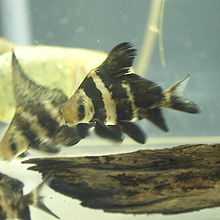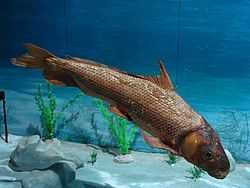Chinese high fin banded shark
| Chinese high fin banded shark | |
|---|---|
 | |
| Juveniles | |
| Conservation status | |
| Not Evaluated | |
| Scientific classification | |
| Kingdom: | Animalia |
| Phylum: | Chordata |
| Class: | Actinopterygii |
| Order: | Cypriniformes |
| Family: | Catostomidae |
| Subfamily: | Myxocyprininae |
| Genus: | Myxocyprinus (T. N. Gill, 1878) |
| Species: | M. asiaticus |
| Binomial name | |
| Myxocyprinus asiaticus (Bleeker, 1865) | |
| Synonyms | |
| |
The Chinese high fin banded shark (Myxocyprinus asiaticus) is a popular freshwater aquarium fish[1] that belongs to the Catostomidae family. It grows to about 1.35 m (4 ft 5 in) long[2] and is unsuitable for most home aquariums.[3][4]
In addition to Chinese high fin banded shark, it is also known under many other common names, including Chinese banded shark, Chinese sailfin sucker,[4] high fin (also spelled hi-fin[5]) banded loach, high fin loach, Chinese high fin sucker, sailfin sucker, topsail sucker, Asian sucker, Chinese sucker, wimple carp, wimple,[4] freshwater batfish, Hilsa herring, rough fish, Chinese or Asian zebra high fin shark, Chinese or Asian zebra high fin sucker,[1] Chinese emperor, Siamese sucker,[6] Chinese banded shark,[7] and Entsuyui in Japanese. Despite its common names, it bears no relation to real sharks except that they are both fish.[8]
It has declined drastically due to pollution, dams (preventing its natural breeding migration), overfishing, introduced species and collection for the aquarium trade.[3][4][8] As a consequence it has been placed on the Chinese list of endangered species and is a state protected species.[3][8]
Description

Young Chinese high fin banded sharks normally possess brown bodies bearing three dark-colored slanting bands. During the breeding season, adult males are distinguished from adult females by their red coloration. Adult females are of dark purple color with a broad and vertical reddish area along the body. Juveniles of the Chinese high fin banded sharks are also characterized by high and triangular dorsal finnage that extends up to the rear of the anal fin. The adult appearance is far less distinctive, as they are elongate in shape without the very high dorsal fin.[8] The thick and fleshy[1] lips bear small papillae without barbels. They have a single row of pharyngeal teeth that have comb-like arrangements.[9]
Through adulthood, Chinese high fin banded sharks become darker in appearance. The characteristic pale bands found in young specimens disappear at a length of 30–36 cm (12–14 in),[3] and the species has been referred to as an "ugly duckling in reverse".[8] The maximum size reached by this fish is 1.35 m (4 ft 5 in) in length[2] and 40 kg (88 lb) in weight.[3]
Distribution and habitat
Chinese high fin banded sharks are native to the Yangtze River basin of China.[9] They migrate into relatively fast flowing, shallow headwaters to spawn, but spend the remaining time in the main river sections.[3] The population in the Min River, a tributary of the Yangtze, may have been extirpated.[3]
Life span
In its natural habitat, Chinese high fin banded sharks live for more than 25 years and reaches sexual maturity when 6 years old.[2][3]
In the aquarium
Tank requirements
Chinese high fin banded sharks can thrive only in coldwater aquariums. But they are known to be sensitive to nitrate level changes. They thrive in aquariums that have effective filtration, fast-flowing water[5] over-hanging plant decors, and regular water changes. Due to their inquisitiveness, Chinese high fin banded sharks are placed in tanks that do not have ornaments with narrow spaces, but with soft and smooth substrates.[1]
Chinese high fin banded sharks thrive in aquariums with water temperature ranging from 65 °F (18 °C) to 75 °F (24 °C) and with a water pH range of 6.0 to 7.5.[1]
Behavior
Chinese high fin banded sharks are middle and bottom-tank dwellers. They have a peaceful temperament and are described as exhibiting playful and clown-like swimming manner. They are known to change color depending on their mood. They are compatible with rasboras, danios and Siamese algae eaters. They should not be mixed with barbs and loaches.[1]
Diet
Chinese high fin banded sharks are frequent food searchers. They are omnivorous[5] and can be fed with dried, live and frozen food. They accept brine shrimp, vegetables and bloodworms.[1]
Breeding
Although known to be egglayers, there is no known successful breeding process in an aquarium setting. Males are known to acquire tubercles over their heads and fins once they reach sexual maturity.[1]
See also
References
- ↑ 1.0 1.1 1.2 1.3 1.4 1.5 1.6 1.7 Freshwater batfish, Whozoo.org, December 1999, retrieved on: August 21, 2007
- ↑ 2.0 2.1 2.2 Fishing World Records: Myxocyprinus asiaticus. Retrieved 9 May 2013
- ↑ 3.0 3.1 3.2 3.3 3.4 3.5 3.6 3.7 SeriouslyFish: Myxocyprinus asiaticus. Retrieved 9 May 2013
- ↑ 4.0 4.1 4.2 4.3 Lundie, Adam. Myxocyprinus asiaticus, Fishprofiles.com, 2007, retrieved on: August 21, 2007.
- ↑ 5.0 5.1 5.2 Hi-Fin Banded Shark, Myxocyprinus asiaticus, (Bleeker, 1865), AquariumCentral.com, retrieved on: August 21, 2007
- ↑ Chinese emperor, WhoZoo.org, 2000, retrieved on: August 21, 2007
- ↑ Chinese banded shark (Myxocyprinus asiaticus), Aqua-Fish.net, 2007, retrieved on: August 21, 2007
- ↑ 8.0 8.1 8.2 8.3 8.4 Koga, James S. Chinese high fin banded shark, CSupomona.edu, September 2003, retrieved on: August 21, 2007
- ↑ 9.0 9.1 Froese, Rainer and Pauly, Daniel, eds. (2013). "Myxocyprinus asiaticus" in FishBase. May 2013 version.
External links
| Wikimedia Commons has media related to Myxocyprinus asiaticus. |
- Myxocyprinus asiaticus (Bleeker, 1865), Taxonomic Serial No.: 639710, Taxonomy, ITIS.gov, retrieved on: August 21, 2007
- Photograph of the Chinese high fin banded shark at Mongabay.com